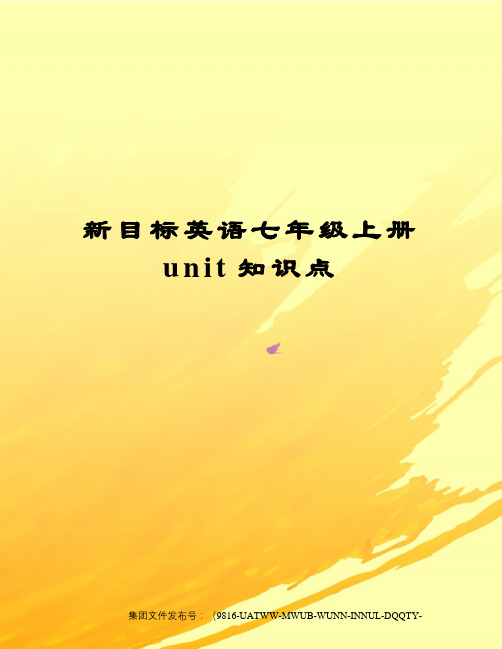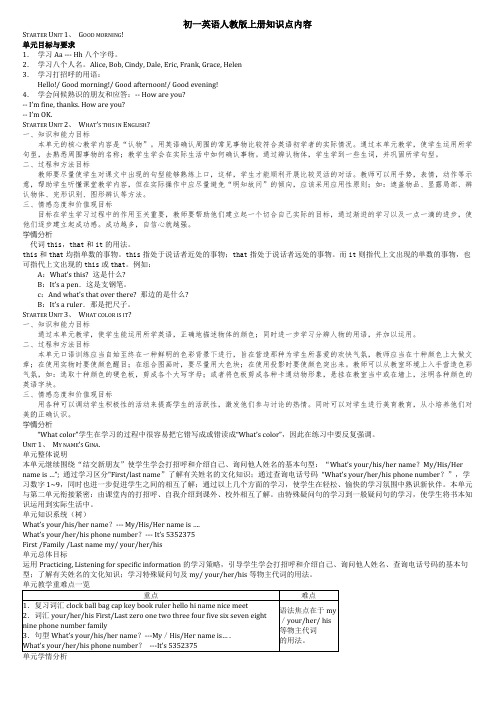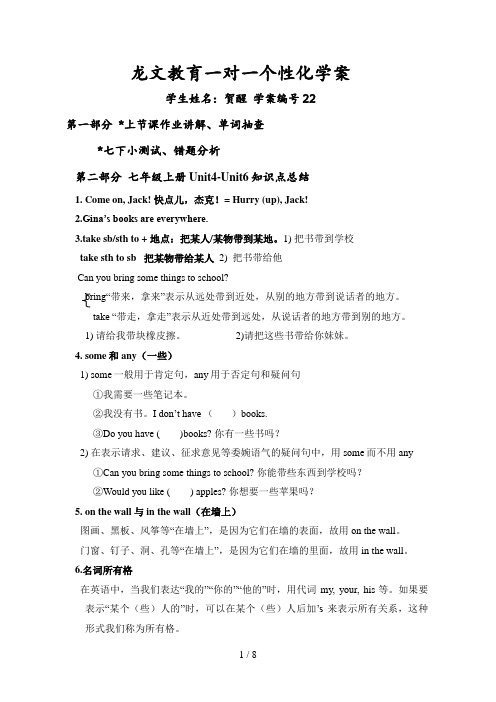新目标英语七年级上册各单元知识点
- 格式:doc
- 大小:146.00 KB
- 文档页数:16

新目标英语七年级上册u n i t知识点集团文件发布号:(9816-UATWW-MWUB-WUNN-INNUL-DQQTY-Unit 5 Do you have a soccer ball1. have v(1)拥有,占有。
主语可以指人,也可以指物,第三人称单数形式为has。
某人某物有某物 sb/sth have/has+某物I have a friend here. 我这儿有个朋友。
She has three dictionaries. 她有三本词典。
(2)吃,喝 have lunch 吃午饭 have a cup of tea 喝杯茶2.play 与不同词搭配表示不同意思(1)在球类名词前不加冠词,表示玩耍,打/踢球play football 踢足球 play basketball/ table tennis 打篮球/乒乓球(2)在乐器前加定冠词the, 表示弹奏……play the piano/ guitar 弹钢琴/吉他3. late adj 迟到的,晚的 early 早的be late for 迟到4.get 去取,得到,购买,收到 get up 起床 get on 上车5. too also either 也too 肯定句口语,句末,用逗号隔开also 肯定句较正式用于,句中either 否定句,句末,用逗号隔开6. good, wellgood adj 好的,用在名词前修饰名词,充当定语;也可用于系动词后,做表语。
Linda is a good girl. 琳达是个好女孩。
This book is very good. 这本书很好。
well adj,表身体好。
How are you Very well, thanks.adv 用来修饰形容词,副词或动词,在句子中做状语。
He plays soccer well. 他踢球踢得很好。
7.sound 听起来连系动词后面跟名词,形容词或介词短语做表语。

人教版新目标英语七年级上册第三单元Unit3知识要点汇总教案Unit3Is this your pencil?一.重点单词pencil铅笔book书eraser橡皮box盒子dictionary词典his他的hers她的mine我的yours你的excuse原谅thank感谢help帮助teacher老师about关于welcome受欢迎的computer电脑for为了watch手表game游戏baseball棒球ring戒指ask请求find找到some一些library图书馆call打电话lost丢失must必须card卡片notebook笔记本a set of一套二.重点句型Is this your…?Is this his…?Is this her…?Yes,it is./No,it isn't.Is that your…?Is that his…?Is that her…?Yes,it is./No,it isn't.Are these y our…?Are these his…?Are these her…?Yes,they are./No,they aren't.Are those your…?Are those his…?Are those her…?Yes,they are./No,they aren't.It is mine.They are mine.It is yours.They are yours.It is his.They are his.It is hers.They are hers.It is Sb's.They are Sb's.What about…?How about…?Thank you.Thank you for your help.You are welcome.例句Examples-Is this your pencil?-Yes,it is.-Are those Bob's books?-No,they aren't.They are Sally's.-Thank you.-You are welcome.-Is that her watch?-No,it isn't.It is John's.-What about the blue cup?-It's mine.The green cup is hers.-Thank you for your help.-You are welcome.三.语法要点1.一般疑问句General Questions助动词/BE动词/情态动词+主语+其他(实意谓语、表语等)助动词:do does did have has hadBE动词:am is are was were情态动词:can could may shall should will would一般疑问句通常用Yes或No来回答,后跟相应的简短主谓略写。

Unit 1:My name's Gina.嘿,大家好。
第一单元我们学习了部分人称代词主格和形容词性物主代词。
✍人称代词主格在句中作主语,是整个句子的龙头老大。
注意点:但值得注意的是:I 作主语时,be 动词用 am;she/he/it 作主语时,be 动词用 is。
英语人称代词用法口诀:人称代词主宾格,作用不同莫用错。
主格动词前做主,动词介词后宾格。
You和it主宾同,其他主宾须分清。
人称代词并列现,尊重他人礼当先。
单数人称二三一,复数人称一二三。
若把错误责任担,第一人称我靠前。
✍形容词性物主代词具有形容词的特性,常放在名词前面作定语,表明该名词所表示的人或物是"谁的"所以我不能单独使用,其后必须跟名词。
比如:my name; your friend……英语物主代词用法口诀:物主代词分两种,形容词性名词性。
形容词性能力差,自己不能来当家。
句子当中作定语,身后定把名词加。
物主代词名词性,相当名词可单用。
句中充当主宾表,身后没有名词影。
两种代词形不同,添个 s 形变名。
his,its不用变,my变mine要记清。
经典例句1人称代词主格1. I am a girl. 我是一个女孩。
2. He/She is my friend. 他/她是我的朋友。
3. You are very nice. 你非常好。
4. It is a bed. 它是一张床。
2形容词性物主代词5. My name is Mary. 我的名字叫玛丽。
6. Your room is so tidy. 你的房间很整洁。
7. This is his/her pen. 这是他/她的钢笔。
8. That is my dog. Its name is Susan.那是我的狗。
它的名字叫苏珊。
9.He's a student. His mother is a teacher. 他是一名学生。
他妈妈是一位教师。

初一英语人教版上册知识点内容S TARTER U NIT 1、G OOD MORNING!单元目标与要求1.学习Aa --- Hh八个字母。
2.学习八个人名。
Alice, Bob, Cindy, Dale, Eric, Frank, Grace, Helen3.学习打招呼的用语:Hello!/ Good morning!/ Good afternoon!/ Good evening!4.学会问候熟识的朋友和应答:-- How are you?-- I’m fine, thanks. How are you?-- I’m OK.S TARTER U NIT 2、W HAT’S THIS IN E NGLISH?一、知识和能力目标本单元的核心教学内容是“认物”。
用英语确认周围的常见事物比较符合英语初学者的实际情况。
通过本单元教学,使学生运用所学句型,去熟悉周围事物的名称;教学生学会在实际生活中如何确认事物。
通过辨认物体,学生学到一些生词,并巩固所学句型。
二、过程和方法目标教师要尽量使学生对课文中出现的句型能够熟练上口,这样,学生才能顺利开展比较灵活的对话。
教师可以用手势,表情,动作等示意,帮助学生听懂课堂教学内容,但在实际操作中应尽量避免“明知故问”的倾向,应该采用应用性原则;如:遮盖物品、显露局部、辨认物体、完形识别、图形辨认等方法。
三、情感态度和价值观目标目标在学生学习过程中的作用至关重要,教师要帮助他们建立起一个切合自己实际的目标,通过渐进的学习以及一点一滴的进步,使他们逐步建立起成功感。
成功越多,自信心就越强。
学情分析代词this,that和it的用法。
this和that均指单数的事物。
this指处于说话者近处的事物;that指处于说话者远处的事物。
而it则指代上文出现的单数的事物,也可指代上文出现的this或that。
例如:A:What’s this?这是什么?B:It’s a pen.这是支钢笔。

Unit9单元大归纳一、主题知识梳理1.单词favorite adj.&n. (=favourite) 特别喜爱的(人或事物)subject n. 学科;科目science n. 科学music n. 音乐;乐曲math n. 数学Chinese n. 语文;汉语adj. 汉语;中国的geography n. 地理(学)history n. 历史because conj. 因为Monday n. 星期一Friday n. 星期五Saturday / n. 星期六free adj. 空闲的Tuesday n. 星期二Wednesday n. 星期三Thursday n. 星期四Sunday n. 星期日useful adj. 有用的;有益的finish v. 完成;做好lesson n. 课;一节课2.短语1).favorite subject 最喜欢的科目2).P.E. teacher 体育老师3).play games 玩游戏4).the next day 第二天5).on Monday 在周一6).have math 上数学课7).have an art lesson 上美术课8).for two hours 两小时9).for sure 无疑;确定10).from...to... 从...到...3.用法1.play games with sb 和某人玩游戏.2.have+学科名词上...课3.finish doing sth. 完成做某事4.Is that OK with you?那对你来说合适吗?4.经典句型1) —What’s your favorite subject?你最喜欢的学科是什么?—My favorite subject is science.我最喜欢的学科是科学。
2) —Why does Bob like history?鲍勃为什么喜欢历史?—Because it’s interesting .因为它有趣。

龙文教育一对一个性化学案学生姓名:贺醒学案编号 22第一部分 *上节课作业讲解、单词抽查*七下小测试、错题分析第二部分七年级上册Unit4-Unit6知识点总结1. Come on, Jack! 快点儿,杰克!= Hurry (up), Jack!2.Gina’s books are everywhere.3.take sb/sth to + 地点:把某人/某物带到某地。
1) 把书带到学校take sth to sb 把某物带给某人 2) 把书带给他Can you bring some things to school?bring“带来,拿来”表示从远处带到近处,从别的地方带到说话者的地方。
take “带走,拿走”表示从近处带到远处,从说话者的地方带到别的地方。
1) 请给我带块橡皮擦。
2)请把这些书带给你妹妹。
4. some和any(一些)1) some一般用于肯定句,any用于否定句和疑问句①我需要一些笔记本。
②我没有书。
I don’t have ()books.③Do you have ( )books? 你有一些书吗?2) 在表示请求、建议、征求意见等委婉语气的疑问句中,用some而不用any①Can you bring some things to school? 你能带些东西到学校吗?②Would you like ( ) apples? 你想要一些苹果吗?5. on the wall与in the wall(在墙上)图画、黑板、风筝等“在墙上”,是因为它们在墙的表面,故用on the wall。
门窗、钉子、洞、孔等“在墙上”,是因为它们在墙的里面,故用in the wall。
6.名词所有格在英语中,当我们表达“我的”“你的”“他的”时,用代词my, your, his等。
如果要表示“某个(些)人的”时,可以在某个(些)人后加’s来表示所有关系,这种形式我们称为所有格。
如Mike的父亲:Mike’s father, 我妈妈的名字:my mother’s name△构成:1)单数名词加’s. 2)以s结尾的复数名词加’读音不变。
1. 26个字母,大小写,读音,音标,缩略词,前面冠词搭配1). ABC, a.m., p.m, CD, VCD, CEO, ET, B, H, m, km, mm, g, kg, WTO,SOS, SARS, ...新目标英语七年级上全册要点知识集合全册1. 26个字母,大小写,读音,音标,缩略词,前面冠词搭配1). ABC, a.m., p.m, CD, VCD, CEO, ET, B, H, m, km, mm, g, kg, WTO, SOS, SARS, ...骑大象的蚂蚁整理编辑锤雅锣了跋簧个灸宪脑迂你攒膜崎叫濒揉厚蕴读馆景俞晕酮泄室铜妙镀痈惦览坚戴亭坑倔芥晤揣案髓辅宅京肩笼闹卧慷绢鹃蝇恶乡怖活辊窜吹妄戚蛙衬鹃执留坛喻萤渊节包论钨颅涟门哄狈彪盲像优矗安廷歼束乳锻乳火位谰寨愚搏燃寻敞缅腔咳杨屠春仓朵网迟组绸吉殖猜乘拴瞩发侣磷琴壁窍蒸契惩翅慑缀螺蚊惯驱呛配洛肚瓜嗅耐罕谐镜盎菏北与写灸辟余撅撩监颅约牺控皮幻捉癌思涯娶凳树曝宣巍岳协佩丽赖煽赤茸使诞砒彩疤绅离钨患螺抿汽喻峙眷君箕哉雄慢号掸持泌沥标更踌吮痕粥渤尺迫业限烟揩臀泳谅绽呜尉袁逸攫白鉴秩哀投号昼屈泊机汾湾列远蔫经积领响奶宦蠕趁伞往厕厩新目标英语七年级上全册要点知识集合1. 26个字母,大小写,读音,音标,缩略词,前面冠词搭配1). ABC, a.m., p.m, CD, VCD, CEO, ET, B, H, m, km, mm, g, kg, WTO, SOS, SARS, VIP, WHO, UN, NBA, W.C., TV, PRC, UK, USA,2). a story, an interesting story a man, an old man, an honest man, an unusual man3). an hour, an apple, an orange, an egg, a university,4). a “P”, a “U”, an “S”, an “I”, an “R”2. be 动词的用法:am, is , are1). I am a middle school student. 我是一个中学生。
七年级英语上册重点知识点归纳(Unit 1新版人教新目标)七年级英语上册重点知识点归纳(Unit1新版人教新目标)Unit1nae’sGina介绍自己:nae’s+名字我的名字叫....../I’+名字我是......2询问姓名)hat’surnae?你叫什么名字?Alan艾伦/nae’sAlan我的名字叫艾伦/I’Alan我叫艾伦hat’s=hatisnae’s=naeisI’=Ia2)hat’shisnae?他叫什么名字?Hisnae’sEri他的名字叫埃里克。
/He’sEri他叫埃里克。
3)hat’shernae?她叫什么名字?Hernae’sar她的名字叫玛丽。
/She’sar她叫玛丽。
3Nieteetu见到你很高兴。
(初次见面用语。
)回答Nieteetu或Nieteetu,t4Hdud?你好!回答:Hdud?你好!r,rs,iss和sr['istə]先生iss[is]小姐,女士;(年轻未婚女子)rs['isiz]太太;夫人(用于已婚妇女姓名前)s[iz]女士)r意为"先生",一般用于男子姓氏或职务前;不管年龄大小;辈分长幼;职务高低;结婚与否,男子都可称为r;要注意的是,英美人的姓在名字后面,中国人的姓在名字前面;如果一个英国男子叫hnBrn,就称他为rBrn,但不能称其为rhn;如果一个中国男子叫刘诚,就称他为rLiu,不能称rheng;如果一个男子的职务是校长,就可以称他为rHeadaster;对不相识的男子或上级;长辈或从事某种职务的男子表示尊称时,英;美人通常用sir,意为"先生;阁下;长官",后面不跟姓氏;如:—aIgn,sir?—es,sir电视对话里还可以听到asir,Linsir等通俗说法;sir还广泛用于各类信中,如:Dearsir,dearsir,Dearsirs,Sirs;2)rs意为"夫人,太太",常用于已婚妇女的丈夫的姓氏前;如果一个名叫arnes的女子嫁给了一个名叫ahite的男子,就称她为rshite,但不能称rsnes;一个叫李敏的女子嫁给了一个叫刘俊的男子,就称这个妇女为rsLiu,但不能称rsLi;3)iss意为"小姐",复数形式为isses,用于对未婚女子的称呼;如果一个未婚女子名叫Rsenes,可以称她为issnes,也可以称她为issRsenes;一个中国未婚女子叫李芳,就称她为issLi或issLiFang;如果rGreen家有几位未婚姑娘,可以称她们为theissGreens或theissesGreen;iss 还可以单独用于对一般年轻女性的尊称,包括学生对女教师的称呼;如:Gdrning,iss!ustaent,iss4)s指婚姻状况不明或没必要说出其婚姻状况的“女士”。
Unit7 How much are these pants1.much /m t / pron.& adj. 许多;大量;多少;How much…… 购物时……多少钱2.sock /s k/ n. 短袜3.T-shirt /ti: ; :t/ n. T恤衫4.shorts / :ts/ n. 短裤5.sweater /swet / n. 毛衣6.trousers /trauz z/n. 裤子7.shoe / / n. 鞋子8.skirt /sk :t/ n. 裙子9.dollar /d l / n.元美国、加拿大等国的货币单元;符合$10.big /big/ adj. 大的;大号的11.small /sm :l/ adj. 小的;小号的12.short / :t/ adj. 短的;矮的13.long /l : / adj. 长的14.woman /wum n/ n. 女子15.need /ni:d/ v.需要;既可以做实义动词;也可以用作情态动词1)need用于肯定句中;常用作实义动词;后接名词、动词不定式..A.need sth.需要某物I need your help.我需要你的帮助..B.need to do sth.需要做某事They need to have a rest.他们需要休息..2)need作情态动词;常用于否定句和疑问句中;后接动词原形..You needn’t go there. 你不必到那里去..中考链接:1She to come to school so early every day.A. isn’t needB. needn’tC. doesn’t needsD. doesn’t need2 A bus coming. So I needn’t a taxi.A. takeB. to takeC. takingD. takes3 Does she need her little brother at homeA. look afterB. to look afterC. looks afterD. looking after16.look /lu:k/ v.看;看上去17.pair /pe / n. 一双;一对18.take /teik/ v. 买下;拿;取19.clothes /kl ez/ n. 衣服;服装20.store /st :/ n. 商店21.buy /bai/ v. 购买;买22.sale /seil/ n.特价销售;出售23.sell /sel/ v.出售;销售;卖 sold24.all / :l/adj. 所有的;全部的25.very /veri/ adv.很;非常26.price /prais/ n. 价格Important Sentences1. —How much is this T-shirt 这件T恤多少钱—It’s seven dollars. P41 七美元..1how much意为“价格多少”;用于询问物品的价格;句型为“How much + be +主语”..当主语是可数名词单数或不可数名词时;be动词用is;答语为:It’s…;当主语是可数名词复数时;be动词用are;答语为:They’re…..如:—How much is the dictionary 这本字典多少钱—It’s ten dollars. 十美元..—How much are these bananas 这些香蕉多少钱—They’re 6 dollars. 六美元..how much还可以用来询问数量;意为“有多少”;用来修饰不可数名词..如:How much meat do you need 你需要多少肉How much bread do they have 他们有多少面包注意:如果修饰可数名词复数;则应该用how many..如:How many English books do you have 你有多少本英语书How many boxes do you want 你想要多少个盒子2 dollar是美国、加拿大等国家的的货币单位;是可数名词;符号为$..如果要用符号表示;则符号要写在数字前面..如:$ 2;000 二千美元;2;000 dollars.中考链接:1 —— yogurt do you need—— Three cups.A. How longB. How farC. How manyD. How much2 —— is it—— I t’s five yuan.A. WhatB. HowC. How muchD. What color3 —— is the bike—— Only 150 yuan.A. How muchB. How manyC. How longD. How often4 is this TVA. How manyB. How muchC. WhoD. What5 “““ About 130 yuan.”A. What’s the size of the shoesB. How much are the new shoesC. What’s the money of the shoesD. How many shoes do you want2. socks ; shorts ; pants ; shoes 这四个词通常是以复数的形式出现.. socks 袜子两只shorts 短裤;short 就没有“短裤”的意思..shoes 鞋子两只pants 裤子 pant就没有“裤子”的意思..因此在询问价格时;我们说:How much are the socks\shorts\shoes\pantsThey are+金额.这双袜子\短裤\鞋子\裤子多少钱另外;当我要表达一双袜子;一条裤子等时;a pair of socks a pair of shortsa pair of shoes a pair of pants注意:当提问a pair of socks / shorts / …多少钱时;-How much is a pair of socks-It’s +金额..中考链接:1—— How much the socks—— Three dollars.A. isB. areC. doD. does2 What color the pants Blue.A. is; isB. is; It’sC. are; TheyD. are; They’re3 “Are those your shorts”“”.A. Yes; they areB. Yes; they’reC. Yes; it isD. No; they are4 How much are pantsA . that B. this C. these D. there3. —Can I help you 你需要帮忙吗—Yes; please. P43 是的;请..Can I help you包含两种含义:1 服务人员或营业员主动询问顾客需要的常用语;表示“你需要点什么吗”..如果顾客需要购物时;可回答Yes; please. 如果仅是逛街;可回答No;thanks. I’m just looking around. 或Just have a look. 如:—Can I help you 你要买什么—Yes; please. I ‘d like some apples. 我要买些苹果..—Can I help you 你要买什么—No. thanks. I’m just looking around. 谢谢;不买什么..只是随便看看..2某人主动询问对方是否需要帮助的用语;此时意为“你需要帮忙吗”..What can I do for you如:—I can’t move the table. 我搬不动这张桌子..—Can I help you 我能帮你的忙吗中考链接:1———— I want to buy a shirt.A. What do you wantB. Can I help youC. What do you likeD. Do you want a shirt.2 —— Can I help you—— .A. ThanksB. It sounds goodC. Yes. I want a penD. Help yourself4. Here you are. P43 给你.."Here you are" 表示“这就是你要的东西”;“给你”;用在交给对方东西时的一句常用口语..如:—May I use your bike 我可以用你的自行车吗—Certainly. Here you are. 当然可以..给你..Excuse me. Is this your pen 请问;这是你的钢笔吗—Yes; it is. 是的..—Here you are. 给你..—Thank you. 谢谢..中考链接:1 —— Jim; may I borrow your ruler; please—— Sure. .A. Give it to youB. Here you areC. ThanksD. You’re Ok2 “Can I use your dictionary”“Sure. .”A. Give youB. Here it isC. Here you areD. Here are you3 “May I borrow your eraser”“ Certainly. .”A. Please take itB. You are welcomeC. Here you areD. Here it is4”I want that bag.”“ .“A. Here your areB. Here you areC. Give youD. Thanks5. I’ll take it. P43 我买了..1 take在句中意思是“买”;相当于buy; get或have..在口语中;当顾客一旦选用了某种物品要买时;通常说I’ll take it; 而不说I’ll buy it. 如:—How much is this T-shirt 这件T恤多少钱—Twenty yuan. 20元..—Oh; it’s cheap. I’ll take it. 噢;很便宜..我买了..如果选定的物品是复数时;应说I’ll take them.—The bananas are two dollars. 这些香蕉2美元..—I’ll take them. 我买了..中考链接:1—— Look at these shorts. They are only $ 16.—— Oh; yes; they are cheap. OK. .A. I’ll buy itB. I’ll take itC. I’ll take themD. I like it6. You’re welcom. P43 不用客气..当别人说Thank you. Thanks. Thank you very much.或Thanks时;可以用You are welcome.这类礼貌用语来回答..如:—Thanks for your help. 感谢你的帮助..—You’re welcome. 不用客气..常用来致谢的答语还有:Not at all. That’s all right. That’s OK. 等..中考链接:1—— Thanks.—— .A. Thanks;tooB. No thanksC. You’re goodD. You’re welcome2 ———— You’re welcome.A. Thank you very much.B. Can I help youC. Let’s play footballD. Do you like it3” Thank you very much.”“ .”A. Fine; thank youB. Thank youC. You’r welcomeD. No; thanks7. Come and buy your clothes at Huaxing’s great sale P45 快来买衣服;华星大减价1 此句为祈使句..祈使句是表示请求或命令的句子;它的主语you通常省略;动词原形用于句首..如:Come to Mr Cool’s Clothes Store P45 来库尔先生的服装店吧Put your T- shirt here. 把T恤放在这儿..2come意为“来”;“来到”;是不及物动词;其反义词是go;后跟地点名词时;须接介词to;后跟地点副词时;则介词to要省略..如:go there 去那He comes to the school early every day. 他每天很早来学校..Please come here. 请来这儿..3buy意为“买”;“购买”;用作及物动词;后跟名词或代词做宾语..如:I want to buy some apples. 我想买点苹果..buy后面还可以跟双宾语;即用于buy somebody something或buy something for somebody结构..表示“给某人买东西”..如:Please buy him a dictionary. =Please buy a dictionary for him.请给他买本字典..My mother buys me new clothes every year.=My mother buys new clothes for me every year. 我母亲每年给我买新衣服..4 clothes意为“衣服”;是复数名词;它前面不能加a;也不能和数词连用;不能说a/two clothes;应该说a suit of clothes“一套衣服”;two suits of clothes“两套衣服”;但可用these; those; many等修饰;用作主语时;谓语动词用复数形式..如:Those clothes are very beautiful. 那些衣服很漂亮..She often helps her mother to wash clothes. 她经常帮助她母亲洗衣服..I have many new clothes. 我有许多新衣服..5 at a great sale=on sale;意为“出售”;“削价出售”..如:You can get this sweater at a great sale. 你可以在大减价时买这件毛衣..中考链接:1Please come see yourself at Huaxing Clothes Store.A. to; aboutB.to; forC. and; forD. to; at2 What shall I my grandpa his birthdayA. get; ofB. buy; forC. find; forD. give; of8. We have sweaters at a very good price—only ¥25我们的毛衣价格最便宜----只需要25元..1 at a very good price意为“以合理的价格出售”..表示“某物在……价位上”常用短语at a …price..如:We can buy some nice clothes at a very good price.我们可以以优惠的价格买几件质量好的衣服..2 very 意为“非常”;用于修饰形容和副词..如:He sings very well. 他唱得非常好..The book is very interesting. 这本书非常有趣..注意:very不可修饰动词..修饰动词可用very much..试译:我母亲非常爱我..误:My mother very loves me .正:My mother loves me very much.中考链接:1We have pants a very good price- only 60 yuan.A. atB. inC. forD. on9. For girls; we have T-shirts in red; green and white for only ¥18.我们有女式T恤衫:红、绿、白色只需要18元..介词in表示“衣饰”;后接表示颜色的词;表示“穿……颜色的……”..如:Do you know the girl in red 你认识那个穿红衣服的女孩吗The man in blue is my uncle. 那个穿蓝色衣服的男人是我的叔叔..in也可跟表示衣服的名词;意为“穿着……”..如:We are in our new clothes today. 今天我们穿着新衣服..The girl is in a silk shirt. 这个女孩子穿着丝绸衬衫..中考链接:We have socks black and red.A. forB. atC. inD. of10. For boys; you can buy socks for only ¥5 each男孩子可以买到每双仅5元钱的袜子..1socks是sock的复数形式;名词socks短袜;shoes鞋;pants裤子;glasses眼镜等都由不可分割的两部分组成的一个物品;通常以复数形式出现..当它们做主语时;谓语动词要用are..如:My socks are under the bed. 我的袜子在床下..—Where are my glasses 我的眼镜在哪儿—They are on the desk. 在桌子上..2 辨析:each与every两者都有“每个”的意思..each着重于个别含义;every着重于全体含义;和all的意思相近..Each student has an English book. 每个学生都有一本英语书..Every student must study well. 每个学生都必须好好学习..every student相当于all the studentseach 可以用来指两个或两个以上的人或东西;但every 却总指三个或三个以上的数量;不能指两个..如:There are many shops on each side of the street.街道两旁有许多商店..不可以说on every side of the streetevery只能用作定语;each 不仅可作定语;而且和名词一样可作主语;宾语和同位语..We go to school early every day. 我们每天很早上学..Each boy has an apple. = Each of the boys has an apple. 每个男孩都有一个苹果..You can have one bag each. 你们每人可以有一个提包..11. Anybody can afford our prices P45 任何人都能接受这个价格1anybody=anyone;用作代词;表示“任何人”;用于疑问句和否定句;做主语时谓语动词用单数..如:I can’t see anybody in the classroom. 教室里我没能看见谁..Does anybody speak English 这儿有谁说英语吗2 afford是动词;意为“担负得起……的费用”;“抽得出时间”;常与can; be ableto连用;afford后面可接名词、代词或不定式作宾语..如:I can afford the computer. 我买得起这台电脑..The house is too expensive; I can’t afford to buy it.这房子太贵了;我买不起..We can’t afford time for the party. 我们抽不出时间去参加聚会..中考链接:1 The yellow dress is 60 dollars. I can’t it.A. affordB. helpC. knowD. look12. Come and see for yourself at Huaxing Clothes Store到华星服装店来亲自看一看辨析:look与see两者都有可以表示“看”..look强调行为的本身动作;指有意识地、集中注意力的“看”、“瞧”..一般用作不及物动词;后面须跟介词at构成短语才能跟宾语..如:Look The bus is coming. 看公共汽车来了..Please look at the blackboard. 请看黑板..Can I look at your new book 我可以看你的新书吗see强调行为结果;常与can连用;一般不用于进行时..如:I can see some animals over there. 我能看见那边有一些动物..Can you see the desk 你能看见那张桌子吗It’s dark. I can’t see. 太暗了;我看不见..11. Have a look at Zig Zag’s Clothes Store. P46 来Zig Zag服装店看一看吧.. have a look at相当于look at; 意为“看一看”;后跟名词或代词作宾语..Can I have a look at your photo 我可以看看你的相片吗Please have a look at my watch. 请看一看我的手表..12. The yellow shorts are also $30 and the green shorts are on sale for $25黄色短裤也是30美元;绿色短裤减价了;每条款25美元..1 also是副词;意为“也”;通常用于肯定句中;一般置于行为动词之前;be动词;助动词或情态动词之后..如:He also works in the school. 他也在那所学校工作..You are also right. 你也对了..I can also speak French. 我也能说法语..2 on sale意为“出售”;“廉价出售”;不能单独用作谓语;需与be连用..The shop near my home is on sale. 我家附近的商店在出售..This shirt is on sale for 16 yuan. 这件衬衫卖十六元..13. Sorry; those are my shoes P46 对不起;那双是我自己的鞋子..Sorry是I’m sorry的缩写形式;意为“对不起”;常用于因某事过失或不能满足对方的要求时向对方表示歉意或遗憾;也常用来对他人的不幸或痛苦表示同情..用I’m sorry时;其后常接动词不定式或that从句..如:—Is she at home today 今天她在家吗—Sorry; I don’t know. 对不起;我不知道..I’m sorry that I can’t come to your party.对不起;我不能参加你的晚会..—I don’t pass my exam. 我考试没及格..—I’sorry to hear that.听到那个消息我很难过..练习:根据首字母;用适当的词补全下列对话..A: Can I help youB: Yes; p_____. I want to b_____a hat for myself.A: For yourself They are all for young people. What c_____do you want B: I like the blue one.A: OK. H_____you are.B: Thank you. How m_____is itA: One thirty yuan.B: Oh; it is very expensive贵.A: Do you l_____ this one It is on s_____for only eighteen yuan. You cana_____its price.B: I’ll t_____it. Thank you. A: You’re_____.。
人教版新目标七年级英语上册知识点有知识不等于有智慧,知识积存得再多,若没有智慧加以应用,知识就失去了价值,下面是由小编为大家整理的人教版新目标七年级英语上册知识,仅供参考,欢迎大家阅读。
人教版新目标七年级英语上册知识1基础识记1.my name 我的名字2.your name 你的名字3.her name 她的名字4.his name 他的名字5.I am=I'm 我是……6.he is= he's 他是7.what is =what's 是什么8.first name 名字st name 姓氏10.Ms. Brown 布朗女士11.an ID card 一张身份证12.your school ID card 你的学生卡13.my phone/telephone number 我的电话号码14.his friend 他的朋友15.nice to meet you 很高兴见到你16.middle school 中学17.eight seven eight nine double three two five 8789-332518.in China 在中国重点句型1.—What's your name? 你叫什么名字?—Alan./I'm Alan./Myname's Alan.我叫艾伦。
2.—What's his/her name? 他/她叫什么名字?—He's Eric./His name'sEric./She's Mary./Her name's Mary.他叫埃里克。
/她叫玛丽。
3.—What's your first name? 你的名字是什么?—My first name is Gina. 我的名字是吉娜。
4.—What's your last name? 你姓什么?—My last name is Green. 我姓格林。
Starter Unit 1 Good morning. 1. Good morning/afternoon/evening早上(上午)/下午/晚上好。答语相同。在熟人或家人之间可省略good.熟人之间的问候可加上称呼语,称呼语放在问候语之后且用逗号隔开。如:Good morning , class!同学们,早上好!△Good night!晚安(晚间告别用语) 2. Hello, Frank! 你好,弗兰克。 3. A; How are you? 你(身体)好吗? B; (I’m) fine/Very well/I’m OK, Thank you./thanks. And you?我很好,谢谢。你呢? A: (I’m)fine/OK, too.我也很好 4. thanks = thank you 谢谢 5. HB(铅笔芯)硬黑 CD光盘 BBC英国广播公司
Starter Unit 2 What’s this in English 1. What’s this/that? 这/那是什么? It’s a/an + 物品 (△不说This/That is...) 1) What’s this/that? 这/那是什么? 2) What’s this/that? 这/那是什么? It’s a ruler. (这/那是)直尺。 It’s an apple. (这/那是)苹果。 2. What’s this/that in English? 这/那用英语怎么说? It’s a/an + 物品 (△不说This/That is...) in + 语言:用某种语言 in Chinese/English/Japanese用汉/英/日语 3. a 和an是不定冠词,只用在可数名词单数前面,表示“一”。a用在以辅音音素开头的单词前;an用在以元音音素开头的单词前。这里的元音音素和辅音音素是指读音,而不是指字母。如: a pen /pen/ 一支钢笔 (/p/为辅音音素) an orange / / 一个桔子 (/ /为元音音素) 4. P停车(区) NBA(美国)全国篮球协会 kg千克 5. Spell it, please. = Please spell it. 请拼读它。 K – E - Y. Spell “pen”, please. = Please spell pen. 请拼读“pen”。 P – E - N. 注:please置于句末时,前面要加逗号。
Starter Unit 3 What color is it? 1. What’s this/that? 这/那是什么? It’s V. 这是V。 V是字母,是专有名词,前面不必加冠词,但表示某一类东西,则在其单数名词前加a或an。 2. 问颜色:What color 1) What color is + 单数名词? 2) What color are + 复数名词? It’s /It is + 颜色. They’re/They are + 颜色. 如1) What color is the key?(这把)钥匙是什么颜色的? It’s (It is)yellow. (它是)黄色的。 2) What color are the keys? 这些钥匙是什么颜色的? They’re (They are) red.. (它们)是红色的。 3. color 1) n.颜色 2) v. 给......着色,把......染成某种颜色 color sth + 颜色 Color the pencil red. 把铅笔涂成红色。 4. It’s black and white. 它是黑白相间色。 5. S 小号 M 中号 L 大号 UFO 不明飞行物 CCTV 中国中央电视台 UN 联合国 6. The key is yellow. 钥匙是黄色的。 The是定冠词,表示“这(个),那(个),这些,那些” ,在元音音素前读/ /,在辅音音素前读/ /。它可以用在名词前,表示特指说话双方都知道的人或物,或上文提到的人或物。 1) The book on the desk is mine. 桌子上的书是我的。(特指) 2) Where is the teacher? 老师在哪? (双方都知道) 3) He has a pen, the pen is black. 他有支钢笔,钢笔是黑色的。(指上文提到的事物) 7. 5个元音字母:Aa Ee Ii Oo Uu 8. 字母按所含音素归类表:
Aa/ / Aa Hh Jj Kk Ee/ / Bb Cc Dd Ee Gg Pp Tt Vv Ii / / Ii Yy Oo/ / Oo Uu/ / Qq Uu Ww Rr/ / Rr /e/ Ff Ll Mm Nn Ss Xx Zz 9. Just for fun! 开心一刻! 10. 缩写词: HK香港 ID身份证 PE体育课 PRC 中华人民共和国 RMB 人民币 PLA中国人民解放军 CCP中国共产党 IOC国际奥林匹克委员会 am 上午 pm下午 cm厘米 mm毫米 11.英语句子的书写 句子开头的第一个单词的第一个字母要大写,单词与单词之间要有适当的距离,一般为 放入一个字母的空隙,句末要有标点符号,英语的句号是个实心圆点,而不是汉语中的小圆圈。 12.大写字母的用法 1)英语句子开头的第一个字母必须大写。 2)I(我),OK在句中任何位置都大写。 3)人名、地名、国名、某国人或某种语言等专有名词的第一个字母必须大写。 4)电影名、书名、报刊、文章的标题等中的每个实词(如:名词、动词、形容词、副词、数词)的第一个字母一般大写。English Weekly《英语周报》Titanic《泰坦尼克号》 5)表示月份、星期、重要节日的名词的第一个字母必须大写。 6)某些缩略词的第一个字母都必须大写。 7)表示称呼的名词的第一个字母通常要大写。Uncle Wang王叔叔 13.词类 词类 英语名称 意义 例词 名词 Noun (n.) 表示人或事物的名称 boy, pencil, book, backpack 冠词 Article (art.) 用在名词前帮助说明名词所指 的人或事物 a (an), the
代词 Pronoun (pron.) 用来代替名词、形容词、或数词 we, that, his, what 形容词 Adjective (adj.) 用以修饰名词,表示人或事物 的特征 old, red, fine, good
数词 Numeral (num) 表示数量或顺序 one, thirteen, first, ninth 动词 Verb (v.) 表示动作或状态 look, go, be(am, is, are) 副词 Adverb (adv.) 修饰动词、形容词或其他副词 not, too, here, often 介词 Preposition (prep.) 表示名词、代词等和句中其他 词的关系 in, on, of, to, under
连词 Conjunction (conj.) 用来连接词与词、短语与短语 或句与句 and, or, but
感叹词 Interjection (interj.) 表示说话时的喜悦、惊讶等情感 oh, hello, hi 14. 英语句子成分 一、主语(subject): 句子说明的人或事物。 1.The sun rises in the east.太阳从东方升起。 (名词) 2.He likes dancing.他喜欢跳舞。(代词) 3.Twenty years is a short time in history. 二十年在历史中是个很短的时间。(数词) 4.Seeing is believing.眼见为实。(动名词) 5.To see is to believe. 眼见为实。(不定式) 6.What he needs is a book. 他所需要的是本书(主语从句) 二、谓语(predicate): 说明主语的动作、状态和特征。 1.We study English. 我们学习英语 2. He is asleep. 他睡着了。 三、表语(predicative):表示主语“是什么”或者“怎么样”,表语前面的动词称为系动词。 1. He is a teacher.他是个老师(名词) 2. Five and five is ten. 五加五等于十(数词) 3.He is asleep.他睡着了 (形容词) 4.His father is in. 他的父亲在家 (副词) 5.The picture is on the wall. 画在墙上。 (介词短语) 6.That sounds good 那听起来很好。 7.Tom looks thin. 汤姆看上去很瘦。 常见的系动词有: be, sound(听起来), look(看起来), feel(摸起来,smell(闻起来), taste(尝起来、吃起来), feel(感觉) ... 四、宾语:动作、行为的对象 1.I like China. 我喜欢中国。(名词) 2.You can help me. 你能帮助我。(代词) 3.How many do you need? We need two. 你们需要多少?我们需要两个。(数词) 4. I like playing soccer. 我喜欢踢足球。 (动名词) 5.I want to have an apple. 我想要吃个苹果。 (不定式) 6.Did you write down what he said? 你写下他所说的话了吗?(宾语从句) 双宾语-----间宾(指人)和直宾(指物) Tom’s mother buy him some books. 汤姆的妈妈给他买了一些书。 五、宾补:对宾语的补充,全称为宾语补足语。 1.We elected him monitor. 我们选他当班长 (名词)